
Table of contents
Commissioner’s Perspective
Participants
NiLab. Nile as Laboratory
Introduction by Ahmed Sami Abd Elrahman, Marina Tornatora, Ottavio Amaro, Moataz Samir, Ghada Farouk Hassan
The flow of the imagination
Presentation by Gianfranco Neri
Project as Research.
Nile as Laboratory
Marina Tornatora, Ottavio Amaro
Nile as collective permanence. The Self, the other and Beyond
Ahmed Sami Abd Elrahman, Moataz Samir
The Nile and “its” landscape
Michael Jakob
Between the Nile in the Netherworld and the Nile in the Sky
Ettore Rocca
NA_01
Geziret El Dahab – Cairo
Dahab Island
Umeå University, Sweden + German University in Cairo, Egypt
NA_02
A Friendly Giant for Rebalancing Nature
Karaman Island – Soha
Sapienza University, Rome, Italy
NA_03
Axis Naturae
Philae Island – Aswan
Manchester School of Architecture + Sheffield Hallam University, UK
AG_04
Reweaving Edfu
Edfu – Aswan
Iuav University of Venezia, Italy + Future University, Khartoum, Sudan
AG_05
City into Nature
El Fawal Island – Behira
Ain Shams University, Cairo, Egypt
AG_06
Egyptian Topography
Sa El Hajar – Gharbia
University of Camerino + University of Udine, Italy
UR_07
Archi-culture
Naqada – Qena
Ain Shams University, Cairo, Egypt
UR_08
The Two Cities
Tell El Amarna – Menia
Politecnico University of Milan, Italy +
Czech Technical University in Prague, Czech Republic
UR_09
Operative Void
Downtown – Cairo
Mediterranea Univerisity of Reggio
Calabria, Lab Landscape_inProgress,
Italy + Parsons University, New York, US
IS_10
Inclusions in Another World High Dam – Aswan
University of Camerino + University of L’Aquila, Italy
IS_11
Between the Infrastructures: Light, Water and Public Spaces
Magra El Oyoun – Cairo
Évora University, Portugal + Iuav
University of Venice, Italy
IS_12
O.A.S.I. KE-MET –Infrastructure of Living World El Qanater El Khayreya –Shubra Elkhema
Federico II University, Naples, Italy + ENSA Paris Malaquais + ENSA
Strasbourg, France
IN_13
City of Boats
Ezbet El Borg – Damietta
Kore University, Enna, Italy
IN_14
Retrofitting [Industrial] Ecologies
Naga Hamady – Qena
Ss. Cyril and Methodius University, Skopje, Macedonia
IN_15
From Concrete to Nature.
Green Industries Headquarters for a Renewed Development of the City
Helwan – Cairo University of Parma, Italy
XI XIV 29 31 37 61 73 83 107 115 123 137 145 153 167 173 181 195 203 211 225 233 241
VII AR_16 Abydos, Act of Palimpsest Abydos Temple – Sohag Grenoble University, France + Ain Shams University, Cairo, Egypt AR_17 Gardens of Nile and Archaeological/Ecological Park Elroda Nilometer – Cairo Valladolid University + Sevilla University, Spain AR_18 Floating Institution Qaitbay Citadel – Rosetta University of Palermo, Italy The Pavilion Afterword by Luca Molinari Credits Biographies Image references 97 161 219 131 189 249 255 263 271 281 307 310 313 314
Project Teams
• NA_01 UMEÅ UNIVERSITY, SWEDEN + GERMAN UNIVERSITY IN CAIRO, EGYPT: Cornelia Redeker, Yosra Malek • NA_02 SAPIENZA UNIVERSITY, ROME, ITALY: Fabrizio Toppetti, Viola Bertini • NA_03 MANCHESTER SCHOOL OF ARCHITECTURE + SHEFFIELD HALLAM UNIVERSITY, UK: Loris Rossi, Laura Pedata, José Ángel
Hidalgo Arellano, Nicolas Turchi • AG_04 IUAV UNIVERSITY OF VENICE, ITALY + FUTURE UNIVERSITY, KHARTOUM, SUDAN: Mauro Marzo, Sandro Grispan, Gabriele Catanzano, Mattia Cocozza, Robert Vicentini • AG_05 AIN SHAMS UNIVERSITY, CAIRO, EGYPT: Mohammed Hewidy, Mohamed
El-Fayoumi • AG_06 UNIVERSITY OF CAMERINO + UNIVERSITY OF UDINE, ITALY: Luigi Coccia, Claudia Pirina, Sara Cipolletti, Giovanni Comi, Pietro Ferrara, Alessia Guaiani, Simone Porfiri, Ettore Vadini • UR_07 AIN SHAMS UNIVERSITY, CAIRO, EGYPT: Samah Elkhateeb • UR_08 POLITECNICO UNIVERSITY OF MILAN, ITALY + CZECH TECHNICAL UNIVERSITY IN PRAGUE, CZECH REPUBLIC: Domenico Chizzoniti, Ondrej Cisler, Tommaso Lolli, Elisa Maruelli, Luca Preis • UR_09 MEDITERRANEA UNIVERISITY OF REGGIO CALABRIA, LAB LANDSCAPE_INPROGRESS, ITALY + PARSONS UNIVERSITY, NEW YORK, US: Ottavio Amaro, Marina Tornatora,
Moataz Samir, Cristiana Penna, Eric Franklin Romeo, Maria Lorenza
Crupi • IS_10 UNIVERSITY OF CAMERINO + UNIVERSITY OF L’AQUILA, ITALY: Luca Galofaro, Stefania Manna • IS_11 ÉVORA UNIVERSITY, PORTUGAL + IUAV UNIVERSITY OF VENICE, ITALY: João Magalhães Rocha, Marco Ferrari, Jorge Duarte de Sa • IS_12 FEDERICO II UNIVERSITY, NAPLES, ITALY + ENSA PARIS MALAQUAIS + ENSA STRASBOURG, FRANCE: Angela D’Agostino, Orfina Fatigato, Christelle Lecoeur, Mathieu Mercuriali, Giuseppe D’Ascoli, Giovangiuseppe
Vannelli • IN_13 KORE UNIVERSITY, ENNA, ITALY: Gianluca
Peluffo, Domenico Faraco • IN_14 SS. CYRIL AND METHODIUS UNIVERSITY, SKOPJE, MACEDONIA: Blagoja Bajkovski, Marija Mano Velevska, Slobodan Velevski, Goran Mickovski, Ana Rafailovska • IN_15 UNIVERSITY OF PARMA, ITALY: Enrico Prandi • AR_16 GRENOBLE UNIVERSITY, FRANCE + AIN SHAMS UNIVERSITY, CAIRO, EGYPT: Philippe Liveneau, Noha Gamal Said • AR_17 VALLADOLID UNIVERSITY + SEVILLA UNIVERSITY, SPAIN: Darío Álvarez Álvarez, Antonio
Tejedor Cabrera • AR_18 UNIVERSITY OF PALERMO, ITALY: Zeila Tesoriere, Renzo Lecardane
9

NiLab Nile as Laboratory
XVIII

XIX

NiLab Nile as Laboratory
Ahmed Sami Abd Elrahman, Marina Tornatora, Ottavio Amaro, Moataz Samir, Ghada Farouk Hassan
Some editions of the Architecture Biennale have chosen design as the central element of their narrative. Others have preferred contamination and narrating with more blurred field contours. The risk is certainly to excessively stress a right opening to interdisciplinarity and multidisciplinary languages, without the need for acknowledging skills and roles, leading to a ‘liquid’ and ‘melting’ dimension where architectural design loses its historical function of structural connection to the society and its habitat.
Lesley Lokko’s approach o the 18th edition of the Architecture Biennale, aimed “at architecture as an expanded field of activity”, certainly reflects on opening new horizons, freeing energies and research spaces for architectural design, for how uncertain they may be. In this sense, we believe this must not entail a “metamorphosis” that renounces a job and an art with public value, at the base of collective functional and aesthetic needs.
Like most African territories, Egypt lives a twofold condition of being in the process of freeing itself from neocolonial legacies, while defending itself from new economic and cultural globalization processes, which can violently erase places’ identity and specificity.
Together with the Faculty of Engineering of the Ain-Shams University of Cairo (Egypt), and the dArTe Department of the Mediterranea University of Reggio Calabria (Italy), who curated the Egypt pavilion and have been collaborating in research and teaching activities for years, 24 international Universities have been invited to build the NiLab. In this laboratory, students, teachers, and young researchers have engaged in concrete design practice to discuss the possible scenarios of a macro-theme: the Nile. It was an emblematic opportunity to reflect on the theme of water in the wider context of climate change.
Nowhere as in Egypt, the presence of a watercourse has identified with the history of civilization, in its cultural, scientific, and humanistic aspects. Its extraordinary geographic dimension has drawn natural and anthropic landscapes, nourished cities and productive systems, reserves, and rural landscapes.
Six Nile landscapes – Natura, Agro, Urbe, Infrastructure, Industry, Archaeology – have been developed throughout eighteen design intervention areas, chosen as the scene of an international encounter between Egypt, African populations, and the Planet.
The Project for the Nile is in symbiosis with the idea for the exhibition of the Pavilion: the “threshold” allows entering a spatial-temporal dimension where visitors are immersed in Nile landscapes together with water, nature, and history. The room is a “visual machine” where surreal objects such as the Sun Boat, a metaphor for the journey over Nile, evoking the relationship between water, myth, and archaeology, and the Table, a space to imagine future scenarios through the eighteen exhibited projects, appear alongside the images from the movie Grand Tour on Nile.
Introduction 29


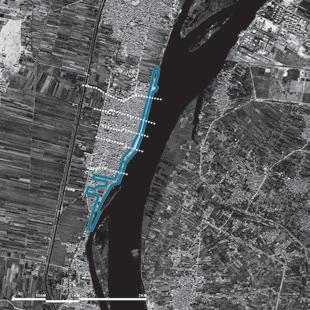
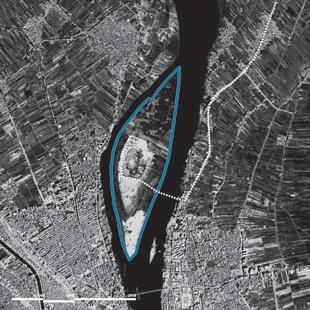



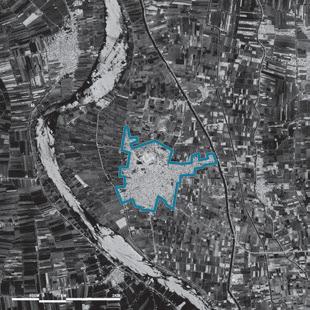
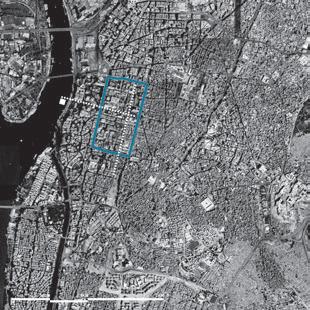
92 Nature NA_01 Dahab Island NA_02 Karaman Island – Sohag NA_03 Philae Island – Aswan Agro AG_04 Edfu – Aswan AG_05 El Fawal Island – Behira AG_06 Sa El Hajar – Gharbia Urbe UR_07 Naqada – Qena UR_08 Tell El Amarna – Menia UR_09 Downtown – Cairo
Infrastructure
IS_10
High Dam - Aswan
IS_11
Magra El Oyoun – Cairo
IS_12
El Qanater El Khayreya
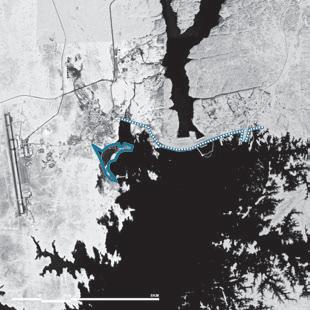


Industry
IN_13
Ezbet El Borg – Damietta
IN_14
Naga Hamady – Qena
IN_15
Helwan – Cairo



Archaeology
AR_16
Abydos Temple – Sohag
AR_17
Elroda Nilometer – Cairo
AR_18
Qaitbay Citadel – Rosetta



93
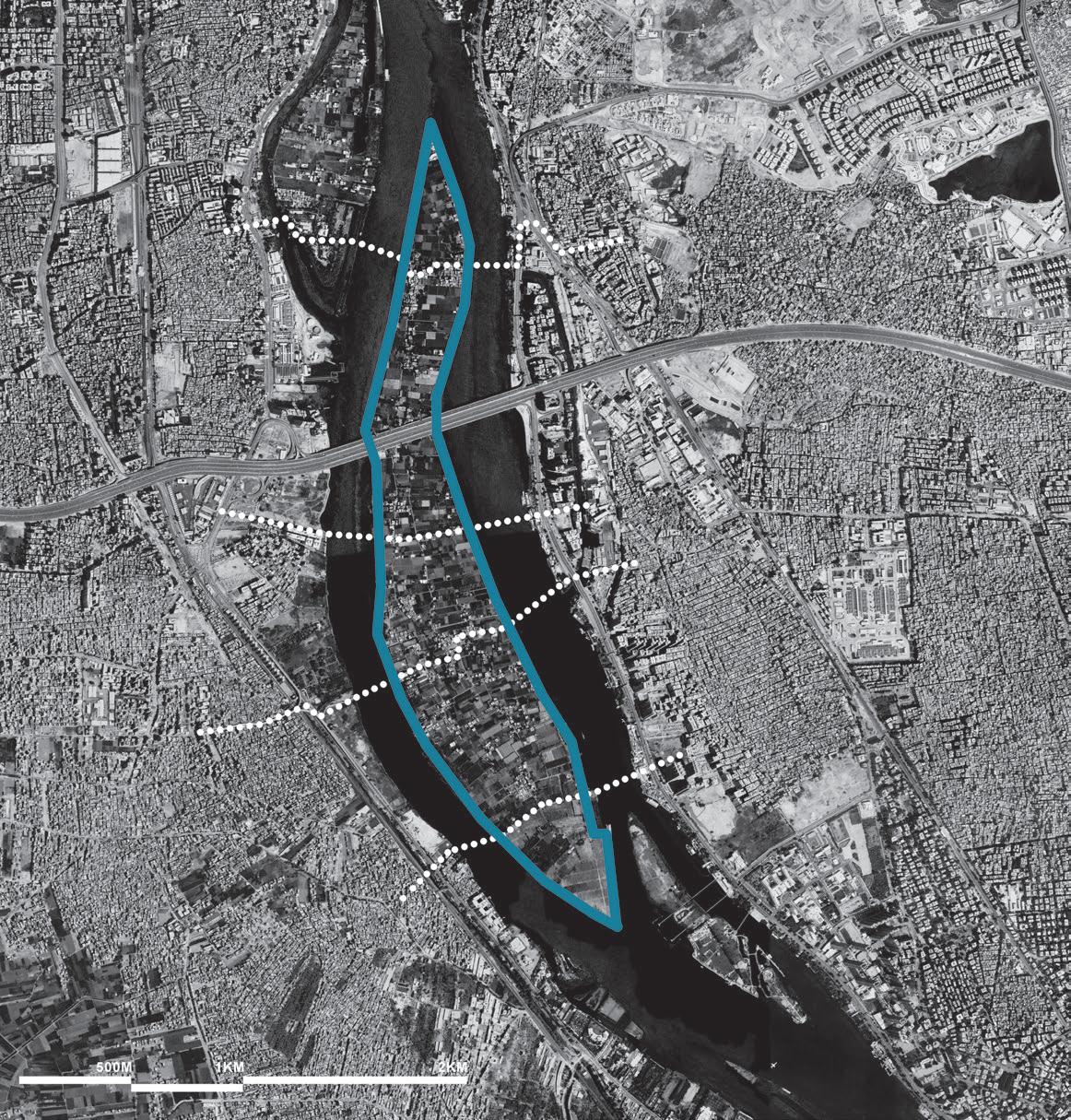
NiLab Nile as Laboratory 106
Dahab Island
Geziret El Dahab – Cairo
Umeå University, Sweden + German University in Cairo, Egypt
Cornelia Redeker, Yosra Malek with Manar Karam, Hassan Hussein, Sara Abu Henedy, Ibrahim Samy, Bassant Adel, Ethar Amr, Youssef Ayman
Site description_Eds
DAHAB ISLAND, Geziret El Dahab, «Island of Gold», located in the Greater Cairo Region, inaccessible by car and reached only by the river, is inhabited by almost 11,000 fishermen and farmers. It is also home to the Prince Nagiub Hassan Palace and other buildings scattered among the farms and crops. Despite its proximity to urban areas, its population still has a rural character.
The island is characterized by three fundamental relationships between its buildings and landscape: natural and geographical components within the urban space, consolidated fabrics and current settlement forms, and its slow construction rhythm within the regional context.
The island is shifting from an agricultural to a globalized modern city model. The intent should be to strengthen the characteristics of the island, which represents a fragment of agriculture within a dense urban fabric. Maintaining a continuous dialogue with the landscape, the territory, and its production system would be essential.
The Dahab Island needs to experiment with a typological settlement scenario where the relationship between nature and architecture could define new landscapes.
Therefore, slow tourism could here take the diffuse architectural form of an “experiential hotel,” reviving the island and making it a destination and/or an exodus from the polluted environments that characterize the Greater Cairo Region.
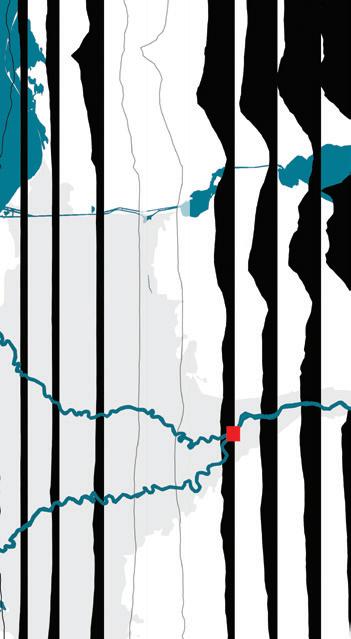
107 Archaeology Industry Infrastructure Urbe Agro
NA_01
Nature

NiLab Nile as Laboratory 166
Naqada – Qena
Archi-culture
Site description_Eds
NAQADA is an Egyptian city on the western bank of the Nile in Upper Egypt, near the city of Qus, in the Qena Governorate. Dating back to the pre-dynastic era (before 2925 BC), it is considered one of the oldest cities of Egypt, where the historical and social evolution of the Nile valley had begun.
The city is rich in handicrafts such as pottery and fabric and is famous for cultivating sugarcane, dates, grains, and diverse vegetables.
Naqada could be revived by developing the waterfront, linking the Corniche with three axes that mark the city’s main features: the Church, the Mosque, and the Palace.
Moreover, the northern edge of the Corniche could be used to establish a marina for boats and an open exhibition for handicrafts and textile products realized by the residents of Naqada. Connecting the historic center to its waterfront could revitalize it through the three arteries.
Thus, the waterfront project aims to develop an important part of the water banks of the city on the Nile River, to make appropriate use of the spatial potential, to emphasize the historical importance of the place, and to produce economic and social development for residents and visitors.

167
UR_07
Nature Archaeology Industry Infrastructure Agro
Ain Shams University, Cairo, Egypt Samah Elkhateeb with Donia Mostafa, Nadine Khalil, Nadine Mohamed, Donia el Boghdady
Urbe

NiLab Nile as Laboratory 124
Axis Naturae proposes a new order in the biodiversity in the Philae Islands area and beyond that brings back the balanced ecosystem altered by the construction of Aswan Dam while creating a complex net of relationships between nature and culture, earth and water, past and future, that constitutes an open museum in the context of a climate emergency.
After the construction of the Aswan Dam, the Nile achieved flooding stability, avoiding constant disruptions in local people’s lives. However, with many dynamics linked to the cyclical growth and decline of the river, a large number of species moved or just disappeared. In a broader context, in the last decades, the North-South seasonal migrations have also been modified for many species of birds, and in many cases, these migrations have dramatically stopped. As the desert conditions have intensified in the last years, the climate has sharpened, making urgent the creation of a new equilibrium, not just at a regional level, but at a continental scale.
We conceive an infrastructure, like a historical aqueduct, that links the Nile with the Suez and the Persian Gulf towards the East, and the Guinean Gulf and the Mediterranean Sea in the South-West and North areas. The axis modifies its direction in Tabuk (Saudi Arabia) or the Toshka Lakes (South Egypt), that act as kneecap points. Connected to the new infrastructure that crosses the Sahara Desert and the Tropical Savannah, we propose a series of “islands” favouring a new water distribution that enriches biodiversity.
In the near future, several areas of the planet will no longer have a suitable environment for the survival of species. The infrastructure can act as a balancing
system that allows plants and animal species to migrate and find a safe environment where they can thrive again. Axis Naturae brings water to different areas, creating a nuanced distribution through programmatic islands that establish new dynamics in the territory. In this archipelago, each island becomes an oasis that contains cultural, social and natural facilities that activate the different areas along the axis, creating new pockets of natural species. Apart from being a water canal, the axis is also a receptacle of different animal and vegetal species, like a modern-day Noah’s Ark, tha¬t favours the transhumance of fauna and people, disseminates life and nurtures the territory with biodiversity (and nutrients), while engaging with emergent activities, and fostering local culture. These strategies, described in the Islands’ Toolkit, are just a starting point for a more ambitious project to be carried out by regional stakeholders.
Several layers have been considered when creating this new landscape, addressing different scales and needs. In our allocated area, we propose a series of cultural facilities (education and exhibition hubs, temples, museums and heritage), leisure amenities (shaded areas, piers, swimming pools, and panoramic points), natural-related activities (seed farming, birdwatching stations, green oasis), and productive schemes (agricultural oasis, potable water reservoirs, fish farms). All those activities are related and linked with the proposed structure, creating a new order where social, natural, cultural and symbolic are linked.
In the past, the Nile was not just a physical entity but a seedbed of culture, influencing Western and Middle Eastern cultures. Following this legacy, the Axis Naturae is conceived as a timeless global spine that opens a dialogue with the
existing, becoming a connective bridge, a river that fertilizes the land and creates a new nature distribution, a cultural counterpoint to a natural environment, a structure that contains memory and dialogues with the existing heritage. Like a contemporary Grand Tour, a present-day temenos (τέμενος) that establishes new relationships between land, lakes, islands and atolls. Axis Naturae provokes an experience of the sublime in a new landscape, creating a new Memorial Open Museum that praises nature and culture as a continuum.
Rossi L. (2020), The castle, the rivers and the green belt. Dynamic resilience in Shkodra’s river confluence. In “La resilienza urbana per i cambiamenti globali” Proceedings. XXII Conferenza Nazionale SIU, Società Italiana degli Urbanisti L’Urbanistica Italiana di fronte all’agenda 2019 per lo sviluppo sostenibile, June 5,6,7, 2019 in Matera, Bari (IT). Planum Publisher, pp. 1378-1386.
Rossi L. (2018), Fragments as methodology / an overview of OMB’s research. In “Projecting Shkodra. Operative fragments between lake, river and sea”. (Loris Rossi, Besnik Aliaj, Enrico Porfido Ed.), Tirana, POLIS Press, pp. 12,21.
Rossi L. (2018), Operative Islands in Berat. In “ANTILIA, forme, visioni, immagini sull’isola”. Edited by Fabiana Dicuomo, Giuseppe Resta, Antilia, Gioia del Colle, 2018, p. 6.
Rossi L., Pedata L., Porfido, E., (2018). Floating strategies for Adriatic-Ionian tourism development. In “Proceedings. University of Macerata Italy September 15th-16th.: Enhancing sustainable tourism in adriatic-ionian region through cocreation the role of Universities and public-private partnerships. ©2017 eum Edizioni Università di Macerata, Macerata, pp. 165-189.
Rossi L., Pedata L., Porfido E., Resta G. (2017), Fragile edges and floating strategies along the Albanian coastline. In “The Plan Journal, Resilient Edges. Investigations, strategies and designs for the ecological resilience of coastal and delta areas around the world”, The Plan Journal, Volume 2Issue 2 (2017) Bologna, pp. 685-705.
Stevens J., Rossi L., Janku E. (2017), Landscape in Fragments: A study of an Albanian landscape corridor from Shkodra to the Adriatic Sea. Proceedings. ACSA Fall Conference | Crossings Between the Proximate and Remote, October 1214, 2017, Marfa, TX, ACSA Press, pp. 78-86.
125 Archaeology Industry Infrastructure Urbe Agro
03 ← 1 Nature
NA_
Project
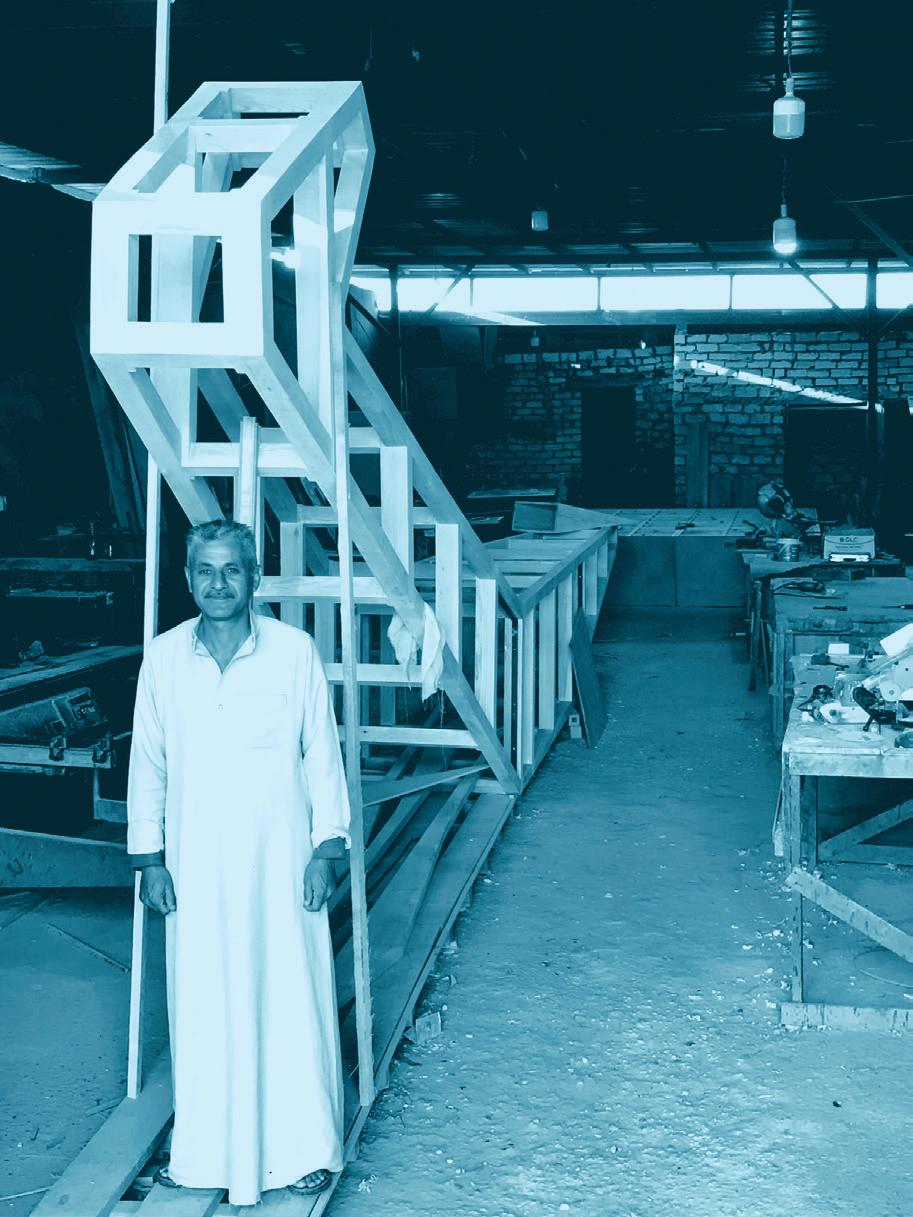
NiLab Nile as Laboratory 284
1. Solar Boat
A 12-meter long model recalls the memory of the historical Solar Boat (2500 BC) kept in the Grand Egyptian Museum, discovered in 1954. Positioned in the center of the pavilion, it is no longer a funerary relic in the Pharaoh’s tomb, but a metaphor and a tool to facilitate a real journey for the visitor immersed in the story of the Nile and its landscapes. The wooden model represents an explicit homage to the theme of water-myth-archeology. A number of 3 wooden oars interact vertically with the horizontality of the boat.
The white envelope of the boat complex will rest on the fluid ground characterized by a projection recalling the flow of Nile water, on which the visitor may will be made to walk.
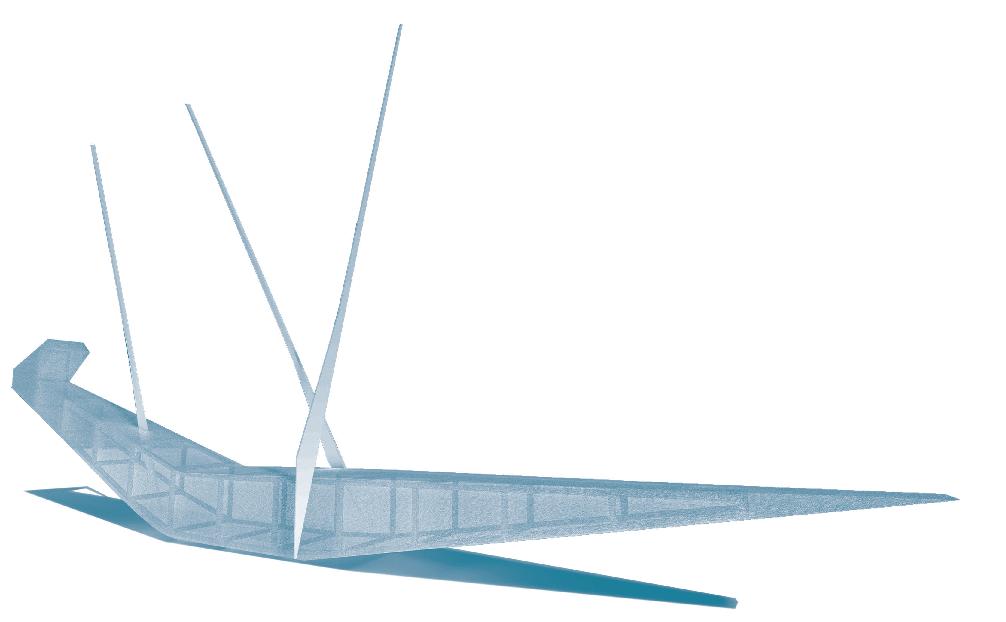
285
The Pavilion

NiLab Nile as Laboratory 302
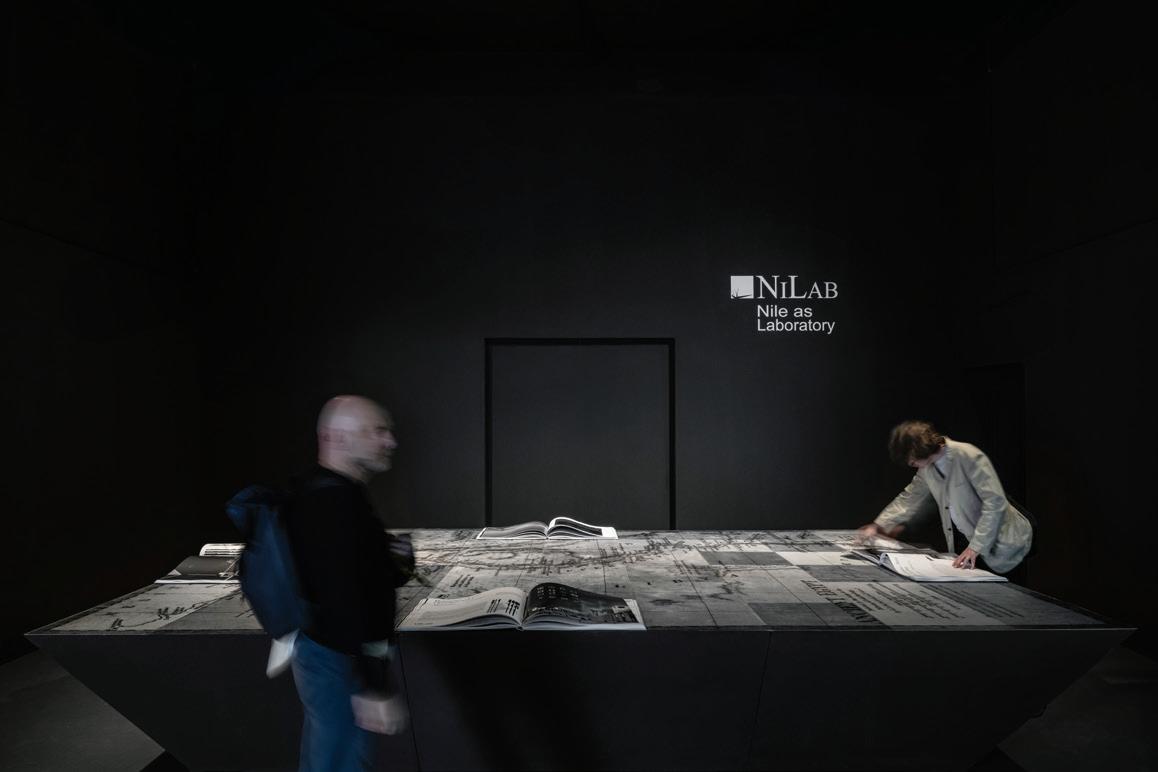
303 The Pavilion

































